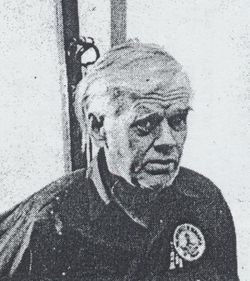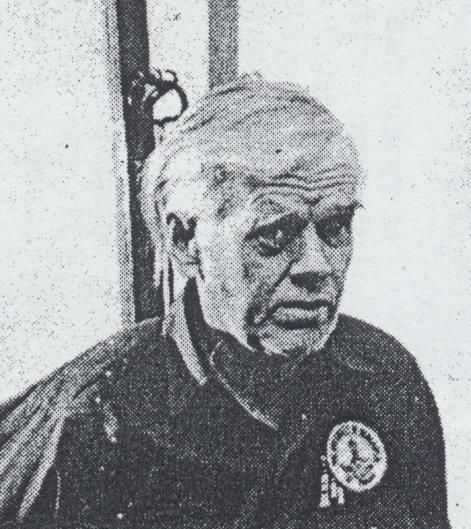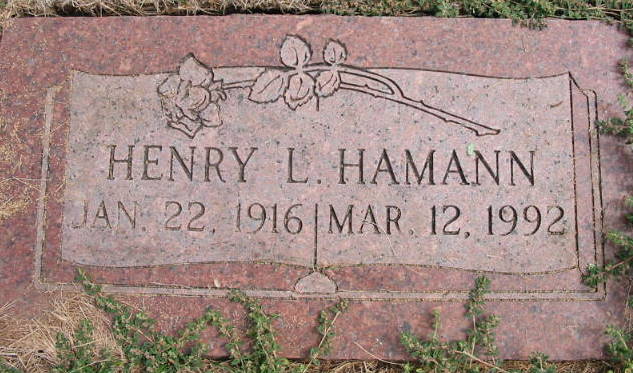"Omaha Streetcar History Hobby of Yard Worker
Henry Hamann who has never driven a streetcar, has one of Omaha's most complete historical collections of streetcar information.
The 36-year-old handler at Union Stockyards has filled the home he shares with his father at 905 S. 33rd street with parts of old streetcars, photographs, uniform buttons and badges, and stacks of notes.
His collection totals more than 60 different articles. It includes the number "71" sign which was on the last Crosstown streetcar to come into South Omaha. He was a passenger on the car.
Horse Token
His "uniform" collection includes a button bearing the imprint of the Omaha-Council Bluffs Railway and Bridge Company which was consolidated with the present firm in 1902.
Tokens include one with the name of Omaha Horse Railway and another designed for use by mail carriers only.
He has attempted to collect pieces of equipment from scrapped cars. Included is a little mirror with a handle on it. Old time streetcar operators stuck the mirror out the window when they changed the cab sign so they would be sure to turn to the right designation.
Mail Car
Mr. Hamann would like to see one of the present cars saved.
"They are unique," he said, "because they were designed and built right here in town."
Included in his photograph collection is a picture of a streetcar that used to pick up mail only. Tracks, he said, went right to the rear doors of the post office.
Among his transfer collections is one from Council Bluffs dated 1893.
Wants Pictures
Mr. Hamann gets most of his information and articles from old railway workers.
He confirmed the fact that horse drawn cars operated in South Omaha.
From talks with old-timers he discovered that the Metropolitan Street Railway Company laid four miles of horse car track in South Omaha in 1893. The track was absorbed in the Omaha Street Railway system in 1902, he said.
He said he would welcome photographs of street scenes with streetcars in them, especially some showing the old horse and mule drawn cars.
Mr. Hamann started his transportation hobby in 1941 because he "wanted a hobby of some kind."
At present he is concentrating on Omaha transportation."
Sun Newspapers 21 March 1974
"Lady Trolley's lifetime recreated
Mementos recall his dead 'lover'
Henry Hamann is having a love affair, and it's not one that will suffer from advancing years and lack of interest.
The only problem is that the object of Hamann's love is dead, and all he has left are well-kept mementos and boxes full of memories.
Hamann's "lover" is the trolley car or streetcar, a fine lady who was born in Omaha around the late 1800s and died here in 1955. Hamann has been collecting memorabilia on her since 1936.
Hamann, a small, slow man who works as a custodian at the University of Nebraska at Omaha, said he doesn't know why he collected trolley items - "I just loved the streetcar." His efforts have probably produced one of the most complete such collections in the area, and they've recreated a period of history that otherwise would have been all too soon lost.
Hamann recently donated his collection to Metropolitan Area Transit (MAT) because he worried about the risk of theft (he collects many other things) and "I'd rather it be someplace where someone could see it."
MAT currently has part of the collection on display in a basement room of its "bus barn" at 2615 Cuming St., but MAT transit planner John Bennett says he hopes to have the collection, which runs into "thousands of items all together" catalogued within a year or so, depending on whether they can acquire display cases.
Henry Hamann's collection is monumental. A stroll through the collection room at MAT brings the old trolley days so vividly to light that all that's missing is the clang from the bell (the bell is in Hamann's collection).
Hamann seems to sense that the trolley days were doomed, and it seems the only thing he neglected to collect was the gum left under his seat.
He has transfers - hundreds and hundreds of transfers - neatly stacked in tiny boxes actually built to hold his transfers. There are streetcar passes for school children dating from 1919 all laid out behind glass. There's a 1930 map showing the trolley car routes in town - with the absolute outer limits being 65th and Maple Streets.
There are big things, too, like the gigantic trolley pole jutting up a good 10 feet or more into the air and the rattan, old-fashioned trolley seat that looks indestructible.
There are streetcar numbers and chalk boards for recording routes and times. Hamann has collected a sand bucket that was placed at the end of the trolley lines so sand could be sprinkled on wet or icy tracks to allow the streetcar to stop. He's got a plaque that was once placed on the old car barn at 20th and Harney streets when it was completed in 1887, as well as the controller mechanism for running the cars.
"That (controller) weighs 700 pounds, and another guy and I had a time carrying it into my apartment" Hamann, a bachelor said.
He's saved three old uniforms, hundreds of uniform buttons in brass (which were designed with a streetcar emblem on them) and tokens from various cities (at one time any city's tokens could be used on the Omaha trolley lines).
Hamann even rode on the last street car to make the run from South Omaha to the car barn on Sept. 2, 1951, and he had the foresight to save the driver's log of the trip. He even had the last ride photographed as the trolley pulled into the station.
The photo is like a scene from an Alfred Hichcock movie - the scene in which Alfred himself appears for a split second. For there, sitting in front of the trolley, his back to the window but in full view of the camera, sits Henry Hamann.
"At one time there were three competing transportation companies in Omaha - a horse car (powered by its namesake), a cable car (run by a constantly moving cable under the trolley tracks like the kind in San Francisco) and the street car. They were in deadly competition, but they later amalgamated," Bennett said.
On the other hand, Council Bluffs was way ahead of its day by completely bypassing the horse-drawn trolley and installing steam motor-propelled trolleys.
An item in the June 13, 1909, Council Bluffs Nonpareil states: "The electric street railway constructed in Council Bluffs was the first successfully operated electric railway of any considerable size in the world." It cost 10 cents to cross the river to Omaha.
MAT learned of Hamann and his remarkable collection from some old-time trolley car drivers who steered Bennett onto him. "We're fortunate that Henry's the kind of guy who saved these things," Bennett said.
Hamann, who belongs to a couple trolley car collectors clubs, said he's bothered by the fact that no one, including MAT, has attempted to save any old trolley cars, although there are some "rotting" in a field somewhere in far North Omaha.
"They're not saving things like they should in Omaha. They destroy everything, dump everything, get rid of it," Hamann said.
Bennett said he's trying to do something about reclaiming one of the old trolley cars."
Hamann's collection is at Pioneer Village in Minden, Nebraska.
"Omaha Streetcar History Hobby of Yard Worker
Henry Hamann who has never driven a streetcar, has one of Omaha's most complete historical collections of streetcar information.
The 36-year-old handler at Union Stockyards has filled the home he shares with his father at 905 S. 33rd street with parts of old streetcars, photographs, uniform buttons and badges, and stacks of notes.
His collection totals more than 60 different articles. It includes the number "71" sign which was on the last Crosstown streetcar to come into South Omaha. He was a passenger on the car.
Horse Token
His "uniform" collection includes a button bearing the imprint of the Omaha-Council Bluffs Railway and Bridge Company which was consolidated with the present firm in 1902.
Tokens include one with the name of Omaha Horse Railway and another designed for use by mail carriers only.
He has attempted to collect pieces of equipment from scrapped cars. Included is a little mirror with a handle on it. Old time streetcar operators stuck the mirror out the window when they changed the cab sign so they would be sure to turn to the right designation.
Mail Car
Mr. Hamann would like to see one of the present cars saved.
"They are unique," he said, "because they were designed and built right here in town."
Included in his photograph collection is a picture of a streetcar that used to pick up mail only. Tracks, he said, went right to the rear doors of the post office.
Among his transfer collections is one from Council Bluffs dated 1893.
Wants Pictures
Mr. Hamann gets most of his information and articles from old railway workers.
He confirmed the fact that horse drawn cars operated in South Omaha.
From talks with old-timers he discovered that the Metropolitan Street Railway Company laid four miles of horse car track in South Omaha in 1893. The track was absorbed in the Omaha Street Railway system in 1902, he said.
He said he would welcome photographs of street scenes with streetcars in them, especially some showing the old horse and mule drawn cars.
Mr. Hamann started his transportation hobby in 1941 because he "wanted a hobby of some kind."
At present he is concentrating on Omaha transportation."
Sun Newspapers 21 March 1974
"Lady Trolley's lifetime recreated
Mementos recall his dead 'lover'
Henry Hamann is having a love affair, and it's not one that will suffer from advancing years and lack of interest.
The only problem is that the object of Hamann's love is dead, and all he has left are well-kept mementos and boxes full of memories.
Hamann's "lover" is the trolley car or streetcar, a fine lady who was born in Omaha around the late 1800s and died here in 1955. Hamann has been collecting memorabilia on her since 1936.
Hamann, a small, slow man who works as a custodian at the University of Nebraska at Omaha, said he doesn't know why he collected trolley items - "I just loved the streetcar." His efforts have probably produced one of the most complete such collections in the area, and they've recreated a period of history that otherwise would have been all too soon lost.
Hamann recently donated his collection to Metropolitan Area Transit (MAT) because he worried about the risk of theft (he collects many other things) and "I'd rather it be someplace where someone could see it."
MAT currently has part of the collection on display in a basement room of its "bus barn" at 2615 Cuming St., but MAT transit planner John Bennett says he hopes to have the collection, which runs into "thousands of items all together" catalogued within a year or so, depending on whether they can acquire display cases.
Henry Hamann's collection is monumental. A stroll through the collection room at MAT brings the old trolley days so vividly to light that all that's missing is the clang from the bell (the bell is in Hamann's collection).
Hamann seems to sense that the trolley days were doomed, and it seems the only thing he neglected to collect was the gum left under his seat.
He has transfers - hundreds and hundreds of transfers - neatly stacked in tiny boxes actually built to hold his transfers. There are streetcar passes for school children dating from 1919 all laid out behind glass. There's a 1930 map showing the trolley car routes in town - with the absolute outer limits being 65th and Maple Streets.
There are big things, too, like the gigantic trolley pole jutting up a good 10 feet or more into the air and the rattan, old-fashioned trolley seat that looks indestructible.
There are streetcar numbers and chalk boards for recording routes and times. Hamann has collected a sand bucket that was placed at the end of the trolley lines so sand could be sprinkled on wet or icy tracks to allow the streetcar to stop. He's got a plaque that was once placed on the old car barn at 20th and Harney streets when it was completed in 1887, as well as the controller mechanism for running the cars.
"That (controller) weighs 700 pounds, and another guy and I had a time carrying it into my apartment" Hamann, a bachelor said.
He's saved three old uniforms, hundreds of uniform buttons in brass (which were designed with a streetcar emblem on them) and tokens from various cities (at one time any city's tokens could be used on the Omaha trolley lines).
Hamann even rode on the last street car to make the run from South Omaha to the car barn on Sept. 2, 1951, and he had the foresight to save the driver's log of the trip. He even had the last ride photographed as the trolley pulled into the station.
The photo is like a scene from an Alfred Hichcock movie - the scene in which Alfred himself appears for a split second. For there, sitting in front of the trolley, his back to the window but in full view of the camera, sits Henry Hamann.
"At one time there were three competing transportation companies in Omaha - a horse car (powered by its namesake), a cable car (run by a constantly moving cable under the trolley tracks like the kind in San Francisco) and the street car. They were in deadly competition, but they later amalgamated," Bennett said.
On the other hand, Council Bluffs was way ahead of its day by completely bypassing the horse-drawn trolley and installing steam motor-propelled trolleys.
An item in the June 13, 1909, Council Bluffs Nonpareil states: "The electric street railway constructed in Council Bluffs was the first successfully operated electric railway of any considerable size in the world." It cost 10 cents to cross the river to Omaha.
MAT learned of Hamann and his remarkable collection from some old-time trolley car drivers who steered Bennett onto him. "We're fortunate that Henry's the kind of guy who saved these things," Bennett said.
Hamann, who belongs to a couple trolley car collectors clubs, said he's bothered by the fact that no one, including MAT, has attempted to save any old trolley cars, although there are some "rotting" in a field somewhere in far North Omaha.
"They're not saving things like they should in Omaha. They destroy everything, dump everything, get rid of it," Hamann said.
Bennett said he's trying to do something about reclaiming one of the old trolley cars."
Hamann's collection is at Pioneer Village in Minden, Nebraska.
Family Members
Sponsored by Ancestry
Advertisement
Advertisement









